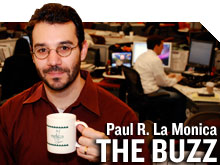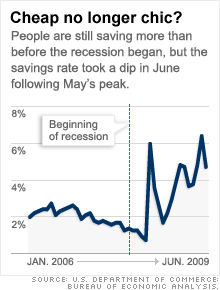It's still cool to be cheap
Although the savings rate dipped in June, economists think it may be a temporary blip -- which is good for the long term but bad for the short term.


NEW YORK (CNNMoney.com) -- Will this newfound culture of thrift soon be a distant memory?
Many consumers say they are acting more responsibly and that this recession has hammered home the importance of saving more and spending less.
Several reports have borne this out.
Consumer spending fell in the second quarter, according to the most recent gross domestic product figures.
And the companies that have held up well during the downturn are those benefiting from the fact that frugality is the new black. Think discount retailers Wal-Mart (WMT, Fortune 500) and Family Dollar Stores (FDO, Fortune 500); purveyors of moderately priced grub such as Yum! Brands (YM); and brewer Molson Coors (TAP, Fortune 500).
But consumers may be slowly lapsing back into bad habits.
According to figures released by the Commerce Department Tuesday, the personal savings rate dipped from 6.2% in May to 4.6% in June.
What's more, it appears that we didn't save as much in June as we once thought. The government originally reported that the savings rate was 6.9% in May before revising it lower.
Now don't get me wrong. Consumers have come very far in a relatively short period of time. Before the recession hit, we were not saving nearly as much as we are now. The savings rate was below 2% for most of 2007 and the first quarter of last year.
Talkback: Have you been saving more because of the recession? If not, why not? Leave your comments at the bottom of this story.
Still, it's worth wondering if the savings rate in May will turn out to be the peak.
Oscar Gonzalez, an economist with John Hancock Financial Services in Boston, does not think so.
He said the decline in the savings rate in June is not a big surprise considering that income had a bit of an artificial pop in May due to the federal stimulus package. So he does not believe that consumers are going to quickly resort to their old ways.
"If you look at the bigger picture, there is a very good chance that we are going to see a return to a time when people are more careful about what they spend," Gonzalez said. "The savings rate will continue to go up and it could rise to between 6% and 10%."
Joseph Liro, an economist with Stone & McCarthy Research Associates, a Princeton, N.J.-based economic and fixed income research firm, also thinks that the June slide in the savings rate may be merely a blip.
Liro said that the painful and precipitous declines in both the housing and stock markets have proven to people that supposedly safe investments are not a substitute for cash in the bank.
"Savings were woefully low at the peak of the last economic cycle. When the economy turned down people were caught with very little savings to fall back on," he said. "People have made a concerted effort to rebuild their savings."
It also goes without saying that as long as the unemployment rate continues to rise, the "recovery" may not feel like much of one for average Americans. That is likely to encourage people to save more as well.
"The overall state of the economy, coupled with steady concerns over job security, has created a quantifiable uneasiness regarding personal finances," said Cathy Weatherford, chief executive officer and president of the Insured Retirement Institute, a nonprofit group focusing on retirement planning strategies, in a statement Tuesday.
However, the boost to savings is both a good thing and a bad thing. For the short-term, many are hoping that consumers will be slightly less conservative.
With the stock market soaring since early March on the belief that the recovery is around the corner, a lot is riding on what consumers do during the second half of the year.
If the back-to-school and holiday shopping periods turn out to be a bust, it will be a lot harder to argue that the economy is really improving. Consumer spending accounts for the overwhelming majority of the GDP after all.
Liro said that consumers may slowly becoming more willing to spend, even for big-ticket items like cars. Ford (F, Fortune 500), for example, reported its first year-over-year increase in sales for July on Monday. GM, Chrysler and Toyota (TM) also posted relatively decent July sales.
But a big portion of these sales came from consumers looking to take advantage of the Cash for Clunkers trade-in program so they could save money on a new car. In other words, the lift in auto sales was a result of consumers continuing to be thrifty.
"People may be enticed to buy a car if you give then a big enough incentive. But other than special circumstances, consumers are still in a defensive stance," he said.
It's uncertain how much longer consumers will stay in this posture. Nonetheless, Gonzalez said that the long-term benefits of consumers getting their financial houses in order outweigh the potential negative impact that lower levels of spending will have in the next year or so.
"It's quite possible that the recovery will be muted. At the very least, consumer spending will be," he said. "But for the long-term this is clearly a positive development. Being more judicious in the way we spend and not spending beyond the reality of our incomes is good."
Talkback: Have you been saving more because of the recession? If not, why not? ![]()

